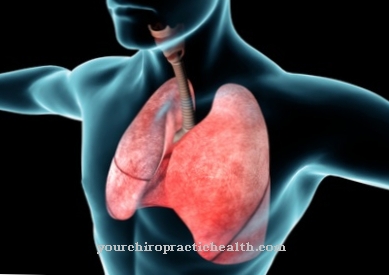Pulmonary breathing - also known as ventilation - is made up of the two components alveolar ventilation and Dead space ventilation together. Dead space ventilation is the proportion of the tidal volume that is not involved in the exchange of carbon dioxide (CO2) for oxygen (O2).
Dead space ventilation arises from the fact that the volume of air that is located in the upstream system of the respiratory tract after inhalation (inspiration) (nasal and pharynx, trachea and bronchi) is exhaled directly again during the subsequent expiration without coming into contact with the alveoli to be.
What is dead space ventilation?

The respiratory tract or the respiratory system consists of the lungs or the alveoli, which make up the functional part of breathing, and the upstream so-called dead space, which is made up of the nose and throat, the trachea and the bronchi.
The functional importance of the dead space lies primarily in the conditioning of the inhaled air through heating - in extreme cases also through cooling - and enrichment with water vapor until saturation as well as in the filtering out of solids (dust) and pathogenic germs.
Breathing is not characterized by a continuous flow of air through the lungs, but is characterized by an alternating system of inhalation (inspiration) and exhalation (expiration). The part of the inhaled air that is in the dead space after inspiration is exhaled directly during the subsequent expiration without coming into contact with the alveoli.
Dead space ventilation also includes the part of breathing that corresponds to the physiologically inoperative part of the lungs, if any. These can be alveoli that have lost their ability to exchange gas due to illness or other influences.
Function & task
The dead space ventilation - at least the anatomical dead space ventilation - results automatically from the fact that the dead space is filled with the inhaled air after inspiration has taken place, as are the alveoli of the lungs. The only difference is that the air volume in the dead space cannot participate in the gas exchange. This means that the air inhaled and exhaled in the dead space does not differ in terms of oxygen and carbon dioxide partial pressure, but only in terms of temperature and relative and absolute humidity.
In healthy people, the function of dead space ventilation is that the anatomical dead space is used for physiological conditioning of the breathing air with regard to temperature and relative humidity and for filtering out dust grains and pathogenic germs.
If the body is subject to a high load with high oxygen demand and maximum ventilation starts, the dead space ventilation affects the maximum performance of the lungs a little, since after expiration has taken place, the air still in the dead space, which already has a lower oxygen content than the ambient air, with a higher carbon dioxide content at the same time anatomical reasons must be inhaled again.
In the resting phase, without physical or psychological stress, the dead space ventilation makes up a considerable part of the overall ventilation. The air volume inhaled with one breath (tidal volume) is approx. 0.5 liters during the resting phase, of which approx. 0.15 liters are accounted for by the anatomical dead space, corresponding to 30%.
The relative share of dead space ventilation in total ventilation decreases sharply with high performance requirements because the tidal volume can rise to a much higher value when using the expiratory and inspiratory reserve volume, while the absolute dead space volume remains almost constant for anatomical reasons.
The absolute size of the functional dead space, including the physiological dead space, can be calculated using the Bohr formula. The absolute size of the dead space including the physiological dead space is then a function of the tidal volume and the carbon dioxide partial pressures of the inhaled and exhaled air.
You can find your medication here
➔ Medication for shortness of breath and lung problemsIllnesses & ailments
Dead space ventilation must always be seen in connection with alveolar ventilation, since both are physically linked. The alveoli cannot be filled with air without the air first flowing through the anatomical dead space, tempering it, bringing it to 100% relative humidity and filtering out solid components such as dust grains and possible germs. Unless the air is inhaled through a tube or an incision in the windpipe (cricothyrotomy).
The determination of the functional dead space can, however, provide indications of the presence of an alveolar dead space if the functional dead space stands out from the anatomical dead space. In people who have a healthy respiratory system, there is no alveolar dead space, so that the anatomical dead space is almost identical to the functional dead space. If it is established that the functional dead space clearly exceeds the anatomical dead space in terms of volume, this is an indication of the presence of an alveolar dead space. This is tantamount to diagnosing that parts of the alveolar system are malfunctioning.
There is then a suspicion of pulmonary emphysema or pulmonary fibrosis, which is caused by chronic inflammatory processes of the intermediate tissue in the area of the alveoli and leads to an irreversible destruction of the alveolar membranes.
Lung fibrosis is triggered either by pathogenic germs or by noxae such as inorganic or organic dusts (e.g. also sprays), as an undesirable side effect of certain drugs or by left heart failure and much more.
Restrictive or obstructive ventilation disorders that impede breathing are due to either lung diseases, a disorder of the respiratory center, diseases or injuries to the respiratory muscles or problems in the area of the anatomical dead space.
Because alveolar ventilation cannot be performed independently of dead space ventilation, ventilation disorders always affect the overall ventilation, regardless of the cause.
























.jpg)



